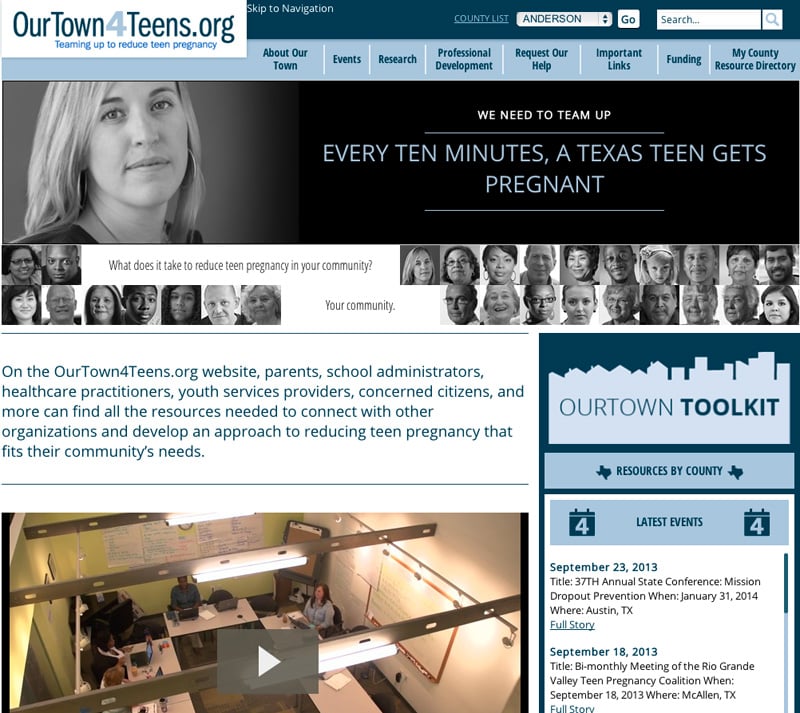
State Health Department Spends $1.2 Million on Abstinence-Only Project
Above: Screen capture of ourtown4teens.org.
In September the Texas Department of State Health Services launched a new website, www.ourtown4teens.org, that will cost $1.2 million over the next year. The agency blitzed the radio and TV with ads for the site, claiming that it will help local communities reduce teen pregnancies. Although the site offers reminders why adolescent pregnancy is to be avoided—girls don’t finish school, babies have worse health outcomes, taxpayers foot the bill—it seems primarily to be a home for buzzwords like “community mobilization,” “strategic action” and “conceptual framework.”
Sadly, if you’re all fired up about combating adolescent pregnancy in your area but you don’t speak jargon, then this website probably isn’t for you.
There’s something else lacking too. The site doesn’t contain a word about contraception, even though Christine Mann, a state health department spokesperson, described the project as a “hub of coordinated information” to help communities reduce teen pregnancy. This omission is especially stark given that Texas’ family planning clinics have been defunded and access to birth control, especially for teens, is a real challenge. Texas also has the third highest teen pregnancy rate in the nation, yet the website sheds no light on one very practical way to avoid an unwanted pregnancy.
That’s because it can’t. Ourtown4teens.org is paid for with federal money from a program called the Title V State Abstinence Education Grant Program. Its sole purpose is to promote abstinence from sexual activity. Title V recipients must use the money to support abstinence from sex before marriage, and teach that sex without marriage could have harmful psychological and physical effects. Birth control doesn’t fit into that world.
Indeed, when asked why ourtown4teens.org doesn’t mention contraception, Mann replied by email: “The campaign focuses on the delay of sexual activity as a way to decrease the teen birth rate and the rate of sexually transmitted diseases. State laws guide the agency, and as a general strategy Texas is an abstinence-first state. Abstinence is our first choice for teens.” She didn’t answer the question about contraception.
The federal Title V abstinence program is a big favorite in Texas. Even though the Obama administration cut abstinence-only funding when evidence showed that programs promoting contraception as well as abstinence—commonly-called “abstinence-plus”—were more effective in reducing teen pregnancy, Texas still prefers to get its money from the abstinence-only spigot. For 2014, the Texas Department of State Health Services received $5.1 million in federal money (some of which paid for this website) from the Title V program, and matched it with another $559,000 from general state revenue.
Local entities in Texas do receive some federal funding for comprehensive pregnancy prevention programs ($7.6 million in 2011 according to the Sexuality Information and Education Council of the United States), but there could have been much more. In 2011, the Texas Freedom Network revealed that the governor’s office and the Texas attorney general prevented the health department from applying for millions of dollars from a federal funding pot known as Personal Responsibility Education Program (PREP). PREP programs promote contraception as well as abstinence.
A determined reader of ourtown4teens.org could find reference to pregnancy prevention programs that do mention contraception. The site also links to national organizations and Texas projects that are really making a difference. But you have to cut through a buzzword thicket and then go to different websites to access any of this information.
Moreover, when asked how the health department would measure the success of the Ourtown4teens.org campaign, Mann wrote: “The evaluation criteria for this project have not yet been finalized.”


